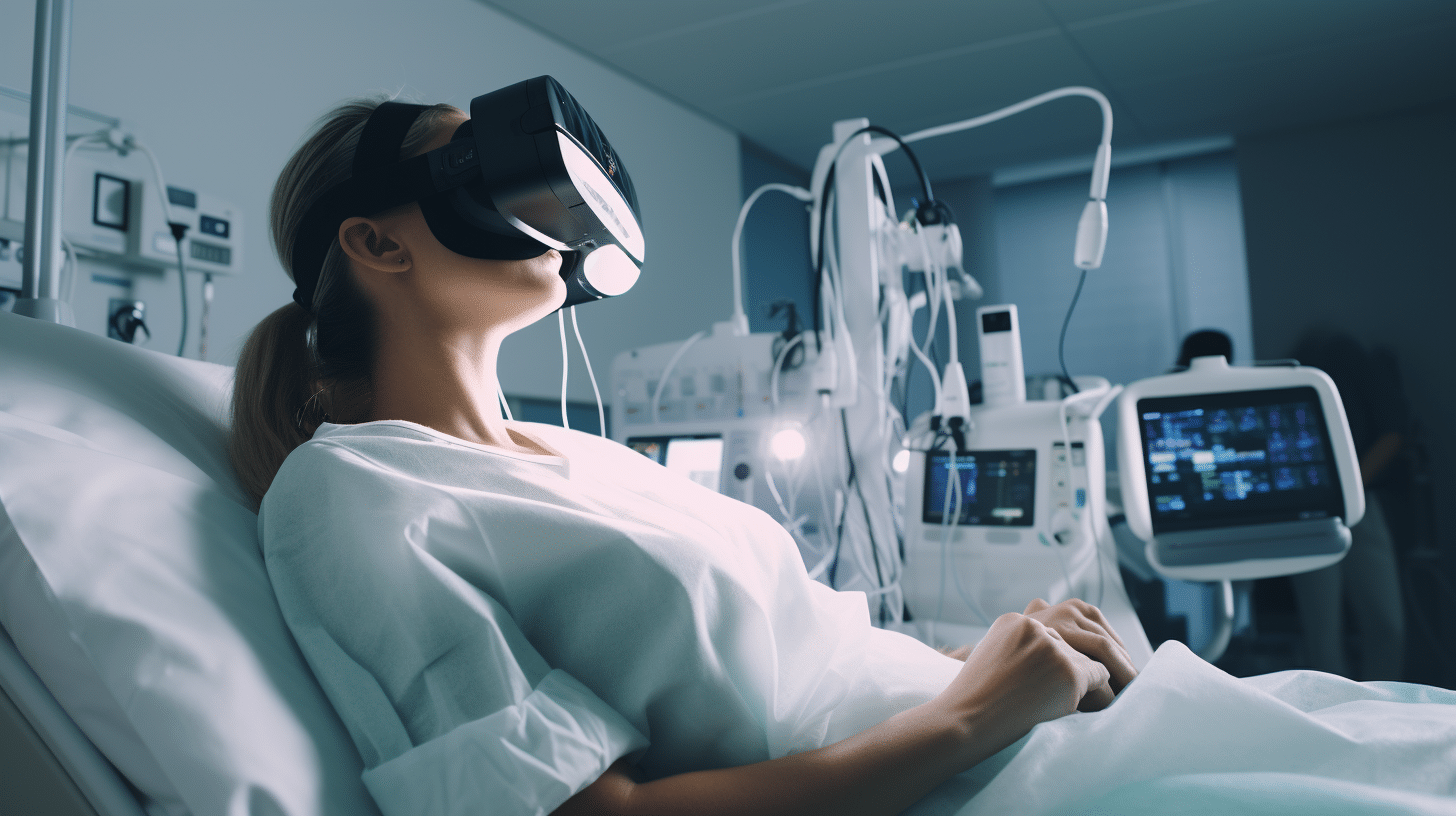VR in Medicine: Bridging Gaps and Improving Access to Care

Virtual Reality (VR) technology is revolutionizing the medical field, providing new opportunities to bridge gaps in access to care and improve patient outcomes. VR in medicine is a rapidly growing field, with applications ranging from medical training and education to patient care and rehabilitation. By leveraging the power of VR, medical professionals can gain access to a wide range of resources and tools to help them provide better care for their patients.
VR in medicine can also help to reduce costs and improve patient satisfaction, as well as provide a more immersive and engaging experience for medical professionals. With the potential to revolutionize the way medical care is delivered, VR in medicine is an exciting and innovative field that is sure to have a lasting impact on the healthcare industry.
What is Virtual Reality in Medicine?
Virtual Reality (VR) in medicine is revolutionizing the way healthcare is delivered. By utilizing the latest in VR technology, medical professionals are able to bridge gaps in access to care and provide more efficient and effective treatments. VR in medicine allows for a more immersive experience for both the patient and the doctor, allowing for a more accurate diagnosis and treatment plan.

With VR, doctors can simulate medical procedures, allowing them to practice and perfect their skills before performing them on a real patient. This technology also allows for remote consultations, allowing doctors to provide care to patients who may not have access to a physical medical facility.
VR in medicine is an exciting and innovative way to improve access to care and provide better outcomes for patients.
The Benefits of VR in Medicine
The use of virtual reality (VR) in medicine is revolutionizing the way healthcare is delivered. By leveraging the power of VR, medical professionals are able to bridge gaps in access to care and provide more effective treatments. VR in medicine allows doctors to simulate medical procedures, diagnose and treat patients remotely, and provide more accurate diagnoses.
VR in medicine also has the potential to improve patient outcomes. By providing a more immersive experience, VR can help patients better understand their conditions and treatments. Additionally, VR can be used to provide more personalized care, allowing doctors to tailor treatments to the individual needs of each patient. This can lead to improved outcomes and better quality of life for patients.
The use of VR in medicine is an exciting and innovative development that has the potential to revolutionize healthcare. By bridging gaps in access to care and providing more personalized treatments, VR can help improve patient outcomes and quality of life.
VR in Medical Education
The use of virtual reality (VR) in medical education is revolutionizing the way healthcare professionals learn and practice medicine. VR technology allows medical students to experience a variety of medical scenarios in a safe, simulated environment, providing them with the opportunity to practice and hone their skills without the risk of harm to patients.
By using VR, medical students can gain a better understanding of the complexities of medical procedures and gain a deeper understanding of the human body. VR in medicine is also helping to bridge gaps in access to care. By providing medical students with the opportunity to practice in a simulated environment, they can gain the skills and confidence needed to provide quality care to underserved populations.
VR technology can also be used to provide remote medical care to patients in remote areas, allowing them to receive the care they need without having to travel long distances. This can help to reduce healthcare costs and improve access to care for those who may not otherwise have access. VR in medicine is an exciting and innovative way to improve medical education and access to care. By providing medical students with the opportunity to practice in a safe, simulated environment, they can gain the skills and confidence needed to provide quality care to underserved populations.
VR technology can also be used to provide remote medical care to patients in remote areas, allowing them to receive the care they need without having to travel long distances. This can help to reduce healthcare costs and improve access to care for those who may not otherwise have access.
VR in Diagnosis and Treatment
The use of virtual reality (VR) in medicine is revolutionizing the way healthcare is delivered. By leveraging the power of VR, medical professionals are able to bridge gaps in diagnosis and treatment, providing more accurate and timely care to patients. VR in medicine is also helping to improve access to care, as it allows medical professionals to provide care to patients in remote locations. With VR, medical professionals can provide virtual consultations, allowing them to diagnose and treat patients without the need for physical contact.
This is especially beneficial for those living in rural areas, where access to medical care can be limited. VR in medicine is also being used to provide more immersive training experiences for medical professionals, allowing them to practice and hone their skills in a safe and controlled environment. With the help of VR, medical professionals can now provide more accurate and timely care to their patients, improving access to care and bridging gaps in diagnosis and treatment.
A Guide to the Different Types of VR Apps: Choosing Your Reality
Exploring VR Study Groups: Collaborative Learning in the Virtual World
VR in Mental Health Care
Virtual reality (VR) is revolutionizing the way we approach mental health care. By providing a safe, immersive environment, VR can bridge the gap between traditional therapy and the patient’s home. VR in medicine is allowing for more accessible and personalized care, allowing patients to receive treatment from the comfort of their own home.
VR in medicine is also providing a more interactive experience for patients. By immersing them in a virtual world, they can explore their emotions and feelings in a safe and controlled environment. This can help them to better understand their mental health issues and develop coping strategies. VR in medicine is also providing a more personalized approach to care, allowing for tailored treatment plans that are tailored to the individual’s needs. VR in medicine is an exciting and innovative way to improve access to mental health care.
By providing a safe and immersive environment, it can bridge the gap between traditional therapy and the patient’s home. It is also providing a more interactive and personalized experience for patients, allowing them to explore their emotions and feelings in a safe and controlled environment. VR in medicine is revolutionizing the way we approach mental health care, and is providing more accessible and personalized care for those who need it.
VR in Surgery
The use of virtual reality (VR) in medicine is revolutionizing the way healthcare is delivered. VR technology is being used to bridge gaps in access to care, improve patient outcomes, and reduce costs. By providing a virtual environment for medical procedures, VR can help to reduce the need for physical contact between patients and healthcare providers, while still providing the same level of care.
VR in surgery is particularly beneficial, as it allows surgeons to practice complex procedures in a safe and controlled environment. This can help to reduce the risk of complications and improve patient outcomes. Additionally, VR can be used to provide remote access to medical care, allowing patients to receive care from a distance. This can help to reduce the cost of care and improve access to care for those who may not have access to a physical healthcare provider.
Overall, VR in medicine is an exciting and innovative technology that is revolutionizing the way healthcare is delivered. By bridging gaps in access to care, improving patient outcomes, and reducing costs, VR is helping to make healthcare more accessible and affordable for everyone.
The Challenges of VR in Medicine
The potential of virtual reality (VR) in medicine is immense. By leveraging the power of VR, medical professionals can bridge gaps in access to care, improve patient outcomes, and revolutionize the way medical treatments are delivered.
VR in medicine has the potential to revolutionize the way medical treatments are delivered, allowing medical professionals to provide care to patients in remote locations, or even in their own homes. VR in medicine can also be used to improve patient outcomes. By providing a more immersive experience, VR can help medical professionals better understand a patient’s condition and provide more accurate diagnoses.
Additionally, VR can be used to simulate medical procedures, allowing medical professionals to practice and refine their skills in a safe and controlled environment. This can help reduce the risk of medical errors and improve patient safety.
The possibilities of VR in medicine are exciting, and the potential for improved access to care and improved patient outcomes is immense. With the right technology and the right approach, VR in medicine can revolutionize the way medical treatments are delivered and help bridge gaps in access to care.
VR Tech Unleashed: Revolutionizing Industries and Beyond
Best VR Games of This Year – Explore Around!
Conclusion
The potential of virtual reality in medicine is truly exciting. By bridging gaps in access to care, VR in medicine has the potential to revolutionize the way healthcare is delivered. With the ability to provide remote consultations, VR in medicine can help to reduce wait times and improve patient outcomes. Additionally, VR in medicine can provide a more immersive experience for patients, allowing them to better understand their condition and treatment options.
With the continued development of VR technology, the possibilities for VR in medicine are endless.
We are only beginning to scratch the surface of what VR in medicine can do, and the future looks bright.
In conclusion, Virtual Reality (VR) in medicine is an exciting and innovative technology that has the potential to bridge gaps and improve access to care. It has a wide range of applications, from medical education to diagnosis and treatment, to mental health care and surgery. While there are still some challenges to overcome, such as cost and privacy concerns, the potential of VR in medicine is undeniable.
With further research and development, VR could revolutionize the way we deliver healthcare and provide more accessible and effective care to patients around the world. It is an exciting time for the medical field and we look forward to seeing the impact of VR in medicine in the years to come.


















